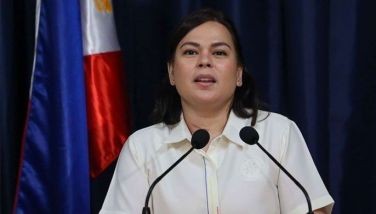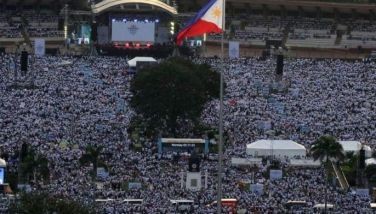The peso’s appreciation might hamper a good recovery

The peso has been appreciating in recent weeks despite the gloomy economic picture, with the economy still experiencing a downturn.
The peso exchange rate as an indicator of value. The value of the peso is an indicator of the health of the economy. The many wiggles of the currency market produce the exchange rate that signals the relative strength (or weakness) of the economy.
In general, many factors will determine when a currency, through pressures or events in the economy or country, become strong or weak. In our history, political factors have played an important part in the volatility of the exchange rate. In times of economic instability, the government had also been weak and unstable.
But market developments and government responses also are important. Sometimes government actions or events outside its control can move a currency to a stronger position, even if the underlying economic fundamentals do not justify it.
A good recovery in the Philippine context should include strengthening the economy’s capacity to enlarge its international earnings, which means reliance on trade – essentially raising export capacity and earnings in international services (through tourism, inward remittances of Philippine factors).
In general, an exchange rate that reflects the capacity of the economy to encourage exports to grow and thrive will help bolster the ability to recover. Hence, for such to happen, the domestic currency cannot be made to strengthen beyond its true economic fundamentals. Where the situation requires recovery from economic crises, such as the one facing the nation today, the exchange rate needs to reflect the realities of the market.
In the last 180 days [inclusive between April 1 to Sept. 26], the average peso-dollar parity was 49.67 pesos to one US dollar. On April 16, the peso exchange rate was 51.02 pesos-to-the-dollar. It reached its lowest rate at 48.35 pesos-to-the-dollar on Aug. 30. Last Sunday, Sept. 27, the rate was quoted at 48.46 pesos-to-the-dollar.
If we chart the daily movements of the exchange rate, we see the ups and downs of the value of the peso. We can also surmise that from April 16 to last Sunday (Sept. 27), the peso has strengthened.
(This “appreciation”, or strengthening of the peso, is paying less pesos for a dollar. This is the opposite of “depreciation,” or weakening, which in exchange rate talk is paying more pesos for a dollar.)
Peso appreciation during the pandemic lockdown period. Should we be surprised with the appreciation of the peso at a time when the economy is weak and is weakening?
Perhaps not, because not all the parts of the economy are in equal weakening status – that is, some sectors or activities are moving in different directions.
For instance, when the lockdown happened, many economic activities stopped and so this reduced not only income and employment, but also caused a big drop in demand and supply of goods – of imports and of exports.
It turned out that during a period of falling activity, Philippine imports fell much more than the fall in exports. Hence there was a relative gain in impact because this situation produced a movement toward a trade surplus. Such a fact would relatively improve or strengthen the currency, hence the impact on appreciation.
Also, take the trade in services. The fall in remittances from OFWs and in earnings from tourism and BPO services were ranged against outward remittances on imports and other services that also became weaker because of the lockdown consequences.
There is still another factor that helped to strengthen fiscal management, which in turn strengthens the Balance of Payments (BOP) position in the immediate term. The government successfully launched a dollar bond issue which brought in fiscal proceeds of significant value, propping up the BOP.
Still, some factors might be at play on the rate of interest in the domestic economy and in the world economy. The worldwide recession caused by the pandemic has made the world’s central banks – led by the US Fed – to sustain a near zero interest rate over a prolonged period.
This led to adjustments in many central banks. Our own BSP took advantage of these opportunities to reduce interest rates. One could ask if the domestic interest rates are still too high to invite inward remittances into the Philippine financial system of foreign funds for speculation and placement. If hot money comes in, a net appreciation effect on the peso could result.
The peso exchange rate, 2000-2020. A review of the peso exchange rate from 2000 to the present is useful to relate the present discussion on the appreciation of the peso.
The first decade from 2000 marked a period of relative depreciation of the peso. It started in year 2000 at 44.88 pesos-to-the-dollar, but rose within five years to a peak of 55.82. The loss of value of the peso was precipitated by political turbulence. This happened during the short presidency of Joseph Estrada, his removal from power and succession by Gloria Macapagal Arroyo. The exchange rate stabilized and later began a slow appreciation toward 47.55 pesos-to-the-dollar – toward the close of the Macapagal Arroyo presidency.
The middle period – 2010 to 2016, during the Benigno Aquino III presidency – marked a period of relative stability of the exchange rate in the range of 44 to 45 pesos-to-the-dollar, with the rate even appreciating to 42.22 pesos-to-the-dollar in 2012.
The improvement in the exchange rate was marked by reigning in government expansion. One outcome, however, was the weak spending on infrastructure investments and inadequate mobilization of fiscal resources.
When the Duterte government began in 2016, there was apparent acceptance of the depreciation of the peso to pay the price for a more aggressive public spending program to expand public investments in infrastructure. This was helped further by the improvement of fiscal mobilization. The peso by 2017 had reached 52.67 pesos-to-the-dollar. The exchange rate had stabilized before the recent appreciation already discussed above.
For archives of previous Crossroads essays, go to: https://www.philstar.com/authors/1336383/gerardo-p-sicat. Visit this site for more information, feedback and commentary: http://econ.upd.edu.p h/gpsicat/
- Latest
- Trending




























